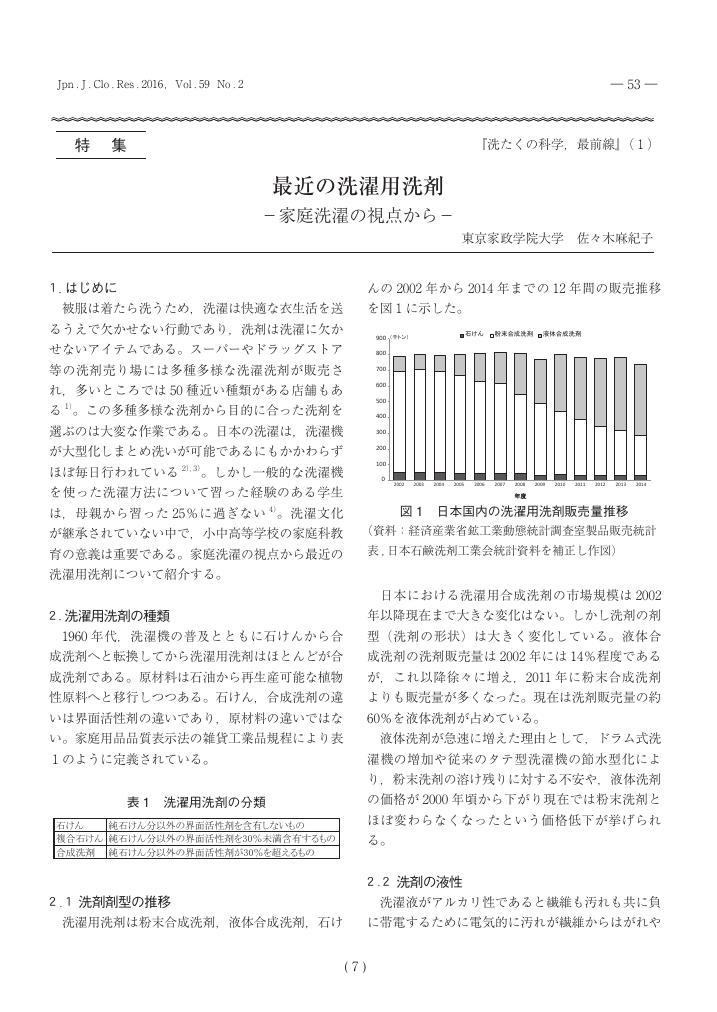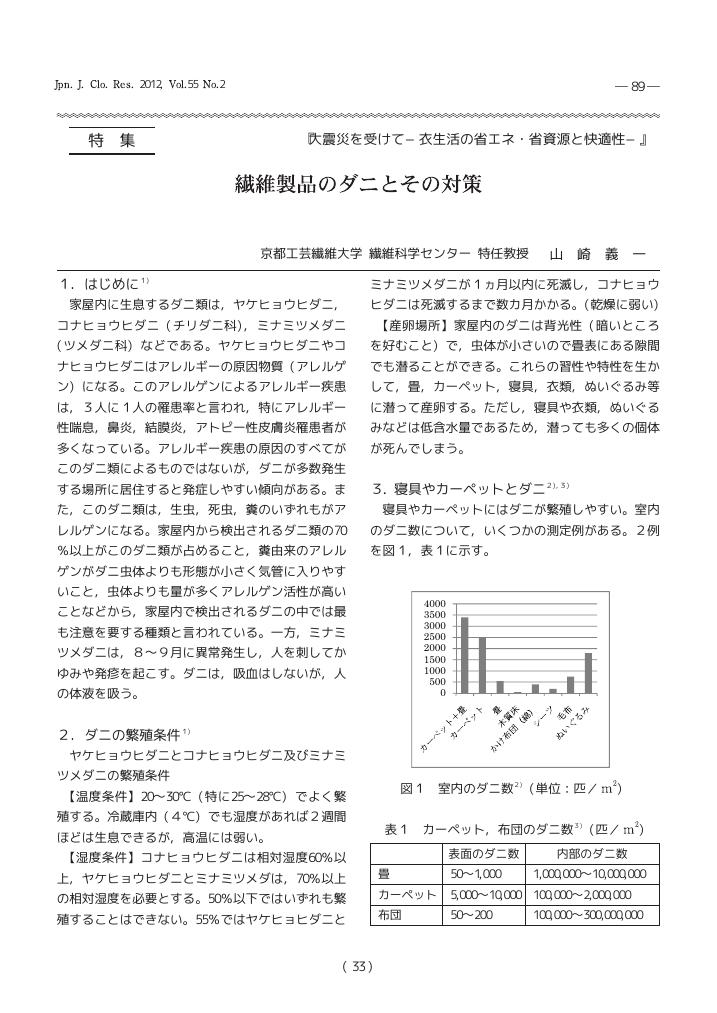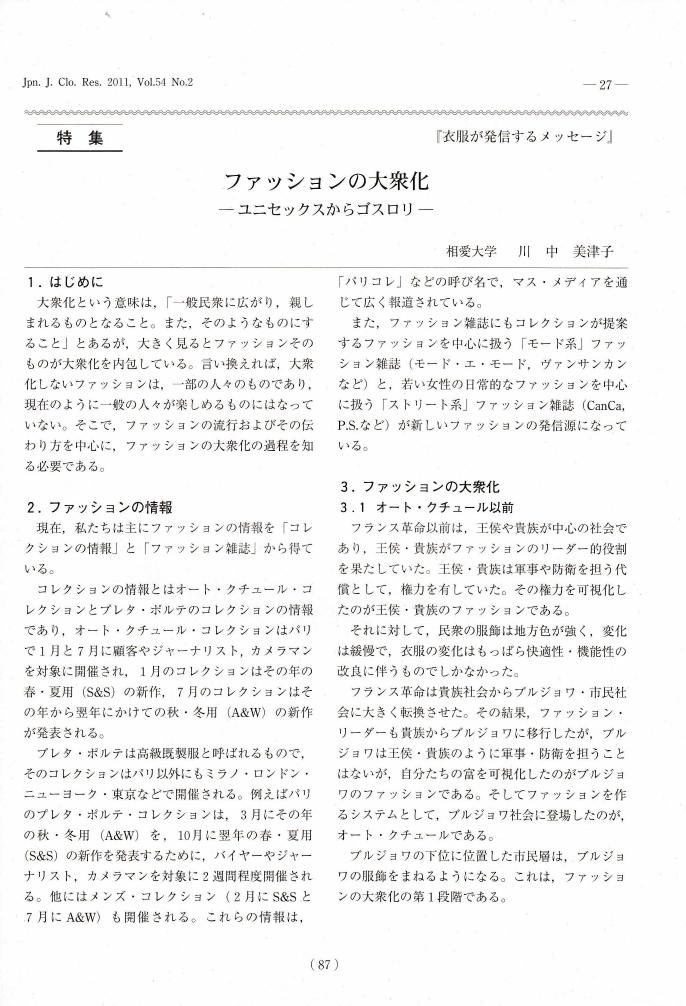11 0 0 0 OA 最近の洗濯用洗剤 −家庭洗濯の視点から−
- 著者
- 佐々木 麻紀子
- 出版者
- 日本衣服学会
- 雑誌
- 日本衣服学会誌 (ISSN:09105778)
- 巻号頁・発行日
- vol.59, no.2, pp.53-56, 2016 (Released:2018-02-22)
- 参考文献数
- 9
5 0 0 0 OA 京都・染織祭と女性時代風俗衣裳 ―服飾史の可視化に挑んだ人々―
- 著者
- 北野 裕子
- 出版者
- 日本衣服学会
- 雑誌
- 日本衣服学会誌 (ISSN:09105778)
- 巻号頁・発行日
- vol.64, no.1, pp.9-14, 2020 (Released:2023-12-12)
- 参考文献数
- 31
5 0 0 0 OA 近代における着物のファッション化と流行模様 ―京都ゑびす講売出しからみる―
- 著者
- 馬場 まみ
- 出版者
- 日本衣服学会
- 雑誌
- 日本衣服学会誌 (ISSN:09105778)
- 巻号頁・発行日
- vol.64, no.1, pp.15-20, 2020 (Released:2023-12-12)
- 参考文献数
- 24
- 著者
- 野上 遊夏
- 出版者
- 日本衣服学会
- 雑誌
- 日本衣服学会誌 (ISSN:09105778)
- 巻号頁・発行日
- vol.63, no.1, pp.11-25, 2019 (Released:2023-02-08)
- 参考文献数
- 75
The purpose of this paper is to clarify how the study of clothing hygiene has developed in modern Japan. Focusing on the works of three medical scientists, Yokote Chiyonosuke, Toda Shōzō, and Ogata Kōhei, we investigated how the context of their research had changed, mainly based on Yokote's book, “Eiseigaku Kōgi” and academic journals, “Kokumin Eisei” and “Ifuku Gakkai Zasshi”. In the Meiji era, Yokote conducted research on clothes based on German hygiene, a cutting-edge approach in those days. He arranged it to suit the actual situation of Japanese clothing life. After that, Toda and his students expanded their research and showed the basic data of clothing hygiene, which established their theoretical basis. During these processes, Ogata founded the Clothing Research Group, which is the predecessor of the Japanese Association for Clothing Studies, in Showa 24 (1949). Ogata considered that the Japanese Association for Clothing Studies should be a society for the study of clothing as a science closely related to human life, and its activity should be interdisciplinary.
5 0 0 0 OA 人と絹の関係 (1)
- 著者
- 清水 重人
- 出版者
- 日本衣服学会
- 雑誌
- 日本衣服学会誌 (ISSN:09105778)
- 巻号頁・発行日
- vol.63, no.1, pp.1-9, 2019 (Released:2023-02-08)
- 参考文献数
- 18
4 0 0 0 OA 寒冷期の避難生活を想定した就寝資材の検討
- 著者
- 根本 昌宏
- 出版者
- 日本衣服学会
- 雑誌
- 日本衣服学会誌 (ISSN:09105778)
- 巻号頁・発行日
- vol.64, no.2, pp.59-63, 2021 (Released:2023-12-12)
- 参考文献数
- 7
4 0 0 0 OA ファッションにみるジェンダー
- 著者
- 馬場 まみ
- 出版者
- 日本衣服学会
- 雑誌
- 日本衣服学会誌 (ISSN:09105778)
- 巻号頁・発行日
- vol.54, no.2, pp.91-94, 2011 (Released:2018-08-09)
- 参考文献数
- 15
3 0 0 0 OA 東日本大震災と石巻専修大学
- 著者
- 坂田 隆
- 出版者
- 日本衣服学会
- 雑誌
- 日本衣服学会誌 (ISSN:09105778)
- 巻号頁・発行日
- vol.61, no.2, pp.45-51, 2018 (Released:2022-01-19)
- 参考文献数
- 6
3 0 0 0 OA 近代化に求められた服装 ―洋服着用状況にみる男女の差―
- 著者
- 馬場 まみ
- 出版者
- 日本衣服学会
- 雑誌
- 日本衣服学会誌 (ISSN:09105778)
- 巻号頁・発行日
- vol.54, no.2, pp.79-82, 2011 (Released:2018-08-09)
- 参考文献数
- 15
2 0 0 0 OA 避難所模擬環境における寝具と衣服が睡眠時の人体に及ぼす影響
- 著者
- 都築 和代
- 出版者
- 日本衣服学会
- 雑誌
- 日本衣服学会誌 (ISSN:09105778)
- 巻号頁・発行日
- vol.64, no.2, pp.65-68, 2021 (Released:2023-12-12)
- 参考文献数
- 6
2 0 0 0 OA ココ・シャネルのファッションスタイル
- 著者
- 藤本 純子
- 出版者
- 日本衣服学会
- 雑誌
- 日本衣服学会誌 (ISSN:09105778)
- 巻号頁・発行日
- vol.54, no.2, pp.83-86, 2011 (Released:2018-08-09)
- 参考文献数
- 9
2 0 0 0 OA 繊維製品のダニとその対策
- 著者
- 山崎 義一
- 出版者
- 日本衣服学会
- 雑誌
- 日本衣服学会誌 (ISSN:09105778)
- 巻号頁・発行日
- vol.55, no.2, pp.89-92, 2012 (Released:2018-02-05)
- 参考文献数
- 9
2 0 0 0 OA 続低体温・凍死と衣服 ―津軽藩士の日記を中心にして―
- 著者
- 吉田 敬一
- 出版者
- 日本衣服学会
- 雑誌
- 日本衣服学会誌 (ISSN:09105778)
- 巻号頁・発行日
- vol.47, no.2, pp.77-85, 2004 (Released:2021-08-19)
- 参考文献数
- 20
1 0 0 0 OA 手指の器用さに関する意識と実態 ―東京都内の私立高校生の場合―
- 著者
- 川端 博子 日景 弥生 鳴海 多恵子
- 出版者
- 日本衣服学会
- 雑誌
- 日本衣服学会誌 (ISSN:09105778)
- 巻号頁・発行日
- vol.47, no.2, pp.99-107, 2004 (Released:2021-08-19)
- 参考文献数
- 6
- 被引用文献数
- 2
We conducted a survey on self-evaluations of skillfulness and attendance in daily activities for private high school students in Tokyo. We also conducted a threads-tying test to determine functional degrees of fingers and hands. We analyzed how skill or lack of skill in using fingers and hands and self-evaluations of skillfulness related to attitudes in daily activities and consciousness towards practical classes. The results are as follows :1. Only about 30% of the high school students evaluated themselves skillful in fingers and hands. They tended to have less confidence about their skillfulness in fingers and hands.2. Analyzing the attitudes in daily activities and reasons, related to self-evaluation of skillfulness, confidence about skillfulness had a relation with positive attendance in daily activities and marks/grades at practical classes.3. The girl students achieved more on threads-tying test than the boy students, which was considered to have relation with the frequency in using fingers and hands in daily activities.4. Self-evaluation of skillfulness did not necessarily coincide with actual skillfulness determined by the test. The sample was divided into the four groups ; skillful, over-estimate, under-estimate and unskillful groups. Considering the characteristic of each group, matters to be paid attention to in educational method in practical classes including sewing class were discussed.
1 0 0 0 OA 近代化と服装 ―洋服と和服の意味―
- 著者
- 馬場 まみ
- 出版者
- 日本衣服学会
- 雑誌
- 日本衣服学会誌 (ISSN:09105778)
- 巻号頁・発行日
- vol.53, no.2, pp.66-72, 2010 (Released:2021-06-15)
1 0 0 0 OA 人と絹の関係 (2)
- 著者
- 清水 重人
- 出版者
- 日本衣服学会
- 雑誌
- 日本衣服学会誌 (ISSN:09105778)
- 巻号頁・発行日
- vol.63, no.2, pp.55-66, 2020 (Released:2023-03-30)
- 参考文献数
- 38
1 0 0 0 OA ケアラベル (洗濯表示記号) の全面的変更 −ケアラベルが12月1日から変わります−
- 著者
- 中里 憲司
- 出版者
- 日本衣服学会
- 雑誌
- 日本衣服学会誌 (ISSN:09105778)
- 巻号頁・発行日
- vol.59, no.2, pp.57-60, 2016 (Released:2018-02-22)
- 参考文献数
- 5
1 0 0 0 OA 被服心理学へのいざない
- 著者
- 中川 早苗
- 出版者
- 日本衣服学会
- 雑誌
- 日本衣服学会誌 (ISSN:09105778)
- 巻号頁・発行日
- vol.54, no.2, pp.69-74, 2011 (Released:2018-08-09)
- 参考文献数
- 17
1 0 0 0 OA インド・サリーの伝統と現代
- 著者
- 杉本 星子
- 出版者
- 日本衣服学会
- 雑誌
- 日本衣服学会誌 (ISSN:09105778)
- 巻号頁・発行日
- vol.51, no.1, pp.7-10, 2007 (Released:2021-03-02)
- 参考文献数
- 6
1 0 0 0 OA ファッションの大衆化 ―ユニセックスからゴスロリ―
- 著者
- 川中 美津子
- 出版者
- 日本衣服学会
- 雑誌
- 日本衣服学会誌 (ISSN:09105778)
- 巻号頁・発行日
- vol.54, no.2, pp.87-90, 2011 (Released:2018-08-09)
- 参考文献数
- 4












